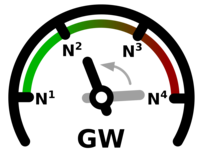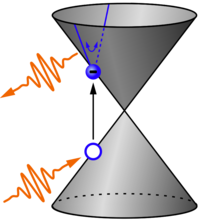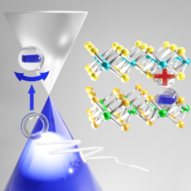
Research
GW method development
GW is a state-of-the-art method to compute band structures of solids and electronic levels in molecules. GW calculations are often used to study charged electronic excitations, to screen promising materials candidates for applications, or to calculate parameters for the use in models. Today's largest supercomputers are required when applying GW to systems with more than hundred atoms in the simulation. Such large-scale calculations are used to model nanoscale molecules and materials with interfaces and defects, for example tailor-made graphene structures used for all-carbon electronics [1,2] or complex two-dimensional materials [3].
 We work on a low-scaling GW algorithm [1,3,4] to enable GW calculations on thousands of atoms. The computational cost of GW can be reduced to O(N²), where N is the number of atoms in the simulation. For two-dimensional materials, we showed that low-scaling algorithms can reduce the computational cost by up to five orders of magnitude [3]. Our low-scaling GW algorithms are implemented in the widely used open-source package CP2K and have been highlighted in a community publication [5].
We work on a low-scaling GW algorithm [1,3,4] to enable GW calculations on thousands of atoms. The computational cost of GW can be reduced to O(N²), where N is the number of atoms in the simulation. For two-dimensional materials, we showed that low-scaling algorithms can reduce the computational cost by up to five orders of magnitude [3]. Our low-scaling GW algorithms are implemented in the widely used open-source package CP2K and have been highlighted in a community publication [5].
Our goal is to extend the low-scaling techniques to other electronic structure methods as the Bethe-Salpeter equation for charge-neutral electronic excitations and to ultrafast electron dynamics.
We also apply our developed methods to pertinent problems in physics and chemistry, in collaboration with experimental groups [2,6].
[1] J. Wilhelm, D. Golze, L. Talirz, J. Hutter, C. A. Pignedoli: Toward GW calculations on thousands of atoms, J. Phys. Chem. Lett. 9, 306-312 (2018).
[2] G. B. Barin, Q. Sun, J. Wilhelm, P. Ruffieux et al.: Growth optimization and device integration of narrow-bandgap graphene nanoribbons, Small 18, 2202301 (2022).
[3] M. Graml, K. Zollner, D. Hernangomez-Perez, P. E. Faria Junior, J. Wilhelm, Low-scaling GW algorithm applied to transition-metal dichalcogenide heterobilayers, arxiv:2306.16066 (2023).
[4] J. Wilhelm, P. Seewald, D. Golze: Low-scaling GW with benchmark accuracy and application to phosphorene nanosheets, J. Chem. Theory Comput. 17, 1662 (2021).
[5] T. D. Kühne, M. Iannuzzi, J. Wilhelm, J. Hutteret al.: CP2K: An electronic structure and molecular dynamics software package - Quickstep: Efficient and accurate electronic structure calculations, J. Chem. Phys. 152, 194103 (2020).
[6] J. Am. Chem. Soc. 140, 3532-3536 (2018), J. Am. Chem. Soc. 141, 2843-2846 (2019), Nat. Commun. 10, 861 (2019), Nat. Chem. 14, 1061-1067 (2022)
Ultrafast electron dynamics
 Recent progress in laser technology made it possible to generate high-intensity ultra-short laser pulses. When irradiating materials with such a laser pulse, the electric field of the pulse accelerates electrons in the material, see sketch. Fingerprints of the ultrafast electron dynamics are encoded in the emission spectrum which is, however, often hard to interpret without a corresponding simulation. We simulate ultrafast electron dynamics to better understand the underlying mechanisms, for example of high harmonic emission or direct-current generation. For simulations, we employ our open-source package CUED [6].
Recent progress in laser technology made it possible to generate high-intensity ultra-short laser pulses. When irradiating materials with such a laser pulse, the electric field of the pulse accelerates electrons in the material, see sketch. Fingerprints of the ultrafast electron dynamics are encoded in the emission spectrum which is, however, often hard to interpret without a corresponding simulation. We simulate ultrafast electron dynamics to better understand the underlying mechanisms, for example of high harmonic emission or direct-current generation. For simulations, we employ our open-source package CUED [6].
Recently, we have developed a quantitative understanding how the carrier-envelope phase of the laser pulse affects the high-harmonic spectrum [7]. Our theoretical work also aims at understanding the latest experiments conducted at the University of Regensburg [8].
[6] J. Wilhelm, P. Grössing, A. Seith, J. Crewse, M. Nitsch, L. Weigl, C. Schmid, F. Evers: Semiconductor Bloch-equations formalism: Derivation and application to high-harmonic generation from Dirac fermions, Phys. Rev. B 103, 125419 (2021).
[7] M. Graml, M. Nitsch, A. Seith, F. Evers, J. Wilhelm, Influence of chirp and carrier-envelope phase on noninteger high-harmonic generation, Phys. Rev. B 107, 054305 (2023).
[8] C. P. Schmid, L. Weigl, P. Grössing, V. Junk, C. Gorini, S. Schlauderer, S. Ito, N. Hofmann, D. Afanasiev, J. Crewse, K. A. Kokh, O. E. Tereshchenko, J. Güdde, F. Evers, J. Wilhelm, K. Richter, U. Höfer, and R. Huber: Tunable non-integer high-harmonic generation in a topological insulator, Nature 593, 385-390 (2021).

